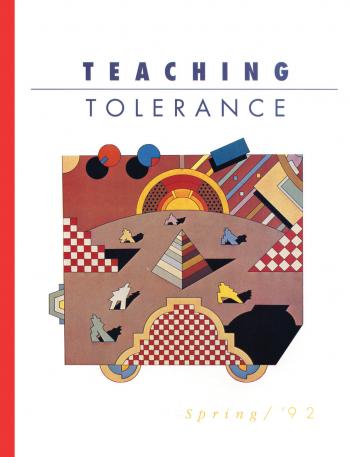
The first two pages of the very first issue of Teaching Tolerance opened with these words: "We share a world. For all our differences of politics, race, economics, abilities, culture and language -- we share one world. To be tolerant is to welcome the differences and delight in the sharing." We'd be wise to include those words in every issue.
Similarly, the first magazine's editorial, written by then-editor Sara Bullard, described a core mission as true today as it was 15 years ago:
"Teaching tolerance is not a new endeavor. Every teacher with more than one student strives for harmony in the classroom. Certainly this task becomes more complicated as the nation and the classroom grow more diverse. But the basic goal remains the same: to care about all of our children and to help them care about each other."
That first issue included an interview with Robert Coles, Harvard professor of child psychiatry and author of The Spiritual Life of Children and the five-volume Children of Crisis series. In response to a question about high-caliber teachers, Coles said, "What good teachers have in common is ordinary common sense. They have thoughtful minds. They have open hearts. They are morally awake. They have a lively sense of humor. ... They have vitality, and goodness of being, and they are just sensitive, decent people."
"Prejudices, it is well known, are most difficult to eradicate from the heart whose soil has never been loosened or fertilized by education; they grow there, firm as weeds among stones."
Charlotte Bronte, 1816-1855
Coles said those words in a different world -- a pre-Columbine, pre-9.11 world, long before anyone heard the phrase No Child Left Behind. Topics covered in recent issues of Teaching Tolerance -- cyber-bullying and transgender students, for example -- simply were not on the educational radar back then.
It's easy for one's cynical voice to arise, to say the "basic goal" described in Sara Bullard's editorial is unachievable, nonexistent.
But it does exist, and one of Teaching Tolerance's goals is to spotlight places where dedicated educators and students have created caring communities, leading us to a deeper understanding of our interdependence.
Can we be better? Certainly, and always. Read Dottie Blais' essay, "Lessons for a Teacher," if you don't believe that. She is one of Coles' thoughtful, lively, sensitive, decent teachers. You'll meet her and other educators in this issue. From California to Florida, on the Lakota Rosebud Reservation and in the aftermath of Hurricane Katrina, the 30th issue of Teaching Tolerance showcases dedicated educators using care and conscience to improve themselves and their schools.
Here's to those teachers, and here's to the next 15 years of Teaching Tolerance—and beyond.
—Brian Willoughby